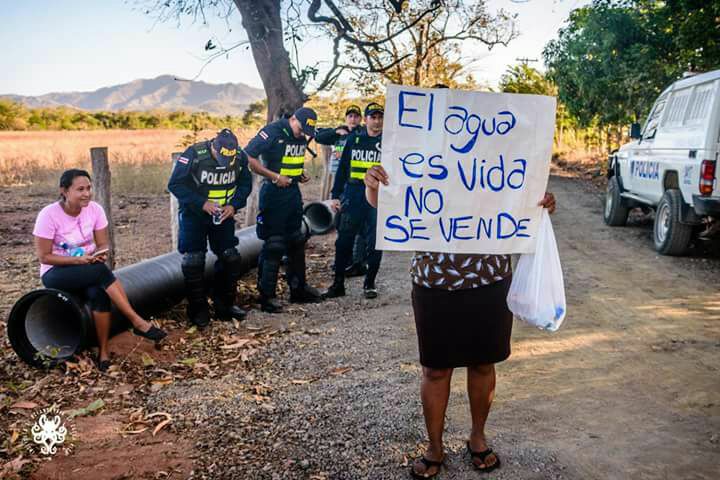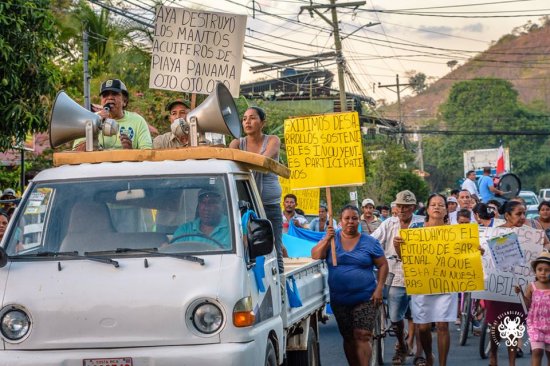
Image from protest in Guanacaste, Costa Rica. Sign translation: Water is life, not for sale
Voices from the South Newsletter

Jessica Morán Jorquera
Jessica Morán Jorquera is a member of, and spokesperson for, The Tourism Alert and Action Forum (TAAF). She brings with her over ten years of experience in cultural heritage and tourism, environmental education, and community participation.
When the so-called “developing” countries are incorporated into the global market system, they are inserted into structures and processes of imperialism and colonialism.
The economic activity of tourism is no stranger to these structures and processes, especially in countries with obedient governments that do not protect their population from unfair trade.
The Tourism Alert and Action Forum (TAAF) analyzes these processes that occur in the name of “development”. Through our analysis, we have been able to deepen our understanding of the term “debt” and relate it to economic growth that fails to recognize the liabilities that it leaves in the territory – such as economic, social, political and cultural deprivations. These impacts directly harm human rights and undermine human dignity in the places where tourism is imposed.
The tourism debt is the moral obligation that the countries of the Global North have to pay to the countries of the Global South in tourism activity, specifically the large tourism industry that leaves deep inequalities in the territories such as economic, social, cultural and political deprivation that directly harm human rights and undermine human dignity.
The debt in tourism, like any other economic activity, is not a spontaneous phenomenon, but rather it has been feeding and accumulating over the years. It is a historical burden that causes huge inequalities within contemporary societies.
Tourism is often presented as an ideal economic activity that promotes the development of communities and which presents few liabilities. However, various cases have shown the opposite. For example, there are various places considered “wonders of the world” or “world heritage” where their communities, in general, are contradictorily poor; even poorer and more vulnerable since the advent of tourism. This is partly due to the fact that these same communities develop a dependency regarding the development of infrastructures and tourist services that are supposedly required to attract international tourists.
It is important to understand that tourism brings many negative impacts and vulnerabilities. It requires the development of expensive infrastructure and it ties Global South communities into tourism global supply chains. As a result, Global South economies get distorted through engagement with international tourism. Additionally, the public commons get usurped by tourism – the beaches, the public parks, the waters, etc. – such that local communities lose their birthright. These factors together are what we refer to as tourism debt. It has both social and ecological features and it is a key factor in why tourism is never developmental in these circumstances.
From TAAF we see the issue of tourism debt as produced by large multinationals and perpetuated by governments, who are joined by tourists and often by the local tourism industry who depredate the resources of the communities, all in order to sustain the value of the tourist experience.
From TAAF we see the issue of tourism debt as produced by large multinationals and perpetuated by governments, who are joined by tourists and often by the local tourism industry who depredate the resources of the communities, all in order to sustain the value of the tourist experience.
To better understand these events, two case studies were carried out in coastal areas where the beaches are privatized for tourism. The cases are: Goa in India and Guanacaste in Costa Rica.
In both cases, tourism capitalizes on the beauty of the landscape, the abundant nature and the rich culture that the territory possesses. Both in Goa and Guanacaste, the population fights for their territory against environmental problems such as the depredation of natural resources, water scarcity, mismanagement of solid waste, as well as social dispossession of land, access to housing and decent work, sexual exploitation of women and children. All these problems affect the fundamental rights of the population in the name of the development of the tourism industry.

Above all, those areas where water is a scarce commodity, specifically in the case of Guanacaste, Costa Rica, the tourism industry misuses and excessively uses water, a resource that is comandeered for tourism infrastructure such as filling swimming pools and irrigating golf courses, instead of prioritizing the use of this resource for vital human consumption.
Faced with these abuses, the population organized and created the Committee for the Defense and Conservation of Water of Sardinal de Carrillo, who recognize that at first they opted to promote tourist activity, since the government pointed out that it would be a great source of income and employment. However, the tourist centers do not provide jobs for the local population and, in fact, take jobs away from local merchants, fishermen and artisans. Add to that tourism-induced inflation and the commodification of water, and you undermine the ability of local people to live and prosper in their own community.
The worst aspect of this situation is the fact that governments do not support their people and instead support the demands of tourism corporations. Local people have not put up with this and have taken steps to understand their circumstances and demand that these injustices be reversed.
“Tourism is not what one expects because they paint a picture of tourism when the reality is very different”
-Eunice Contreras, Interviewed in Sardinal, 2019
“Tourism is not what one expects because they paint a picture of tourism when the reality is very different” -Eunice Contreras, Interviewed in Sardinal, 2019
It does not have to be this way and we propose a set of policies and actions that could correct this situation and ensure that the participation of tourism occurs in a fair and sustainable way. This includes fair remuneration for suppliers, taxes and regulations to support culture and nature, protection of workers’ rights and conditions, and reparation for violations of people’s rights and well-being.
The studies of India and Costa Rica were carried out by TAAF in the year 2020. In the case of Guanacaste, Costa Rica directly supported itself with resources for the necessary legal services for those affected in this local fight.
